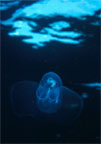|

|
A California sea
lion dives in search of rockfish in the
waters above Cordell Bank. (photo: Gulf of
the Farallones NMS)
|
|

|
An elephant seal
checks out an observer before disappearing
beneath the surface again. Elephant seals
are known to be able to dive to at least
5600 feet. (photo: Gulf of the Farallones
NMS)
|
|

|
Humpback whales
engage in cooperative lunge feeding on
krill-tiny crustaceans abundant over
Cordell Bank. These baleen whales filter
the tiny shrimp-like animals from the
water column in big mouthfuls. (photo: Dan
Shapiro)
|
|

|
Two giant blue
whales, near 100 feet each in length,
appear at the surface of Cordell Bank
before they resume diving. The thick tale
stalk and the two raised blowholes are
characteristic of blue whales, as is their
mottled blue-gray color. (photo: Dan
Shapiro)
|
|

|
Speedy Pacific
white-sided dolphins skim the surface
waters of Cordell Bank as they race to
join others from a herd of 100. These
dolphins typically travel in large groups
and will join fast-moving vessels to ride
the bow waves. (Photo John
Calambokidis)
|
|

|
Yellowtail rockfish
cluster in schools above the densely
covered pinnacles of Cordell Bank. (photo:
Cordell Bank Expeditions)
|
|

|
A mixed species
school of rockfish hang mid water in the
boundless blue ocean above Cordell Bank.
(photo: Cordell Bank
Expeditions)
|
|

|
A rosy rockfish
rests near yellow sponges and strawberry
anemones on the bottom at Cordell Bank.
(photo: Cordell Bank
Expeditions)
|
|

|
A giant ocean
sunfish, or mola mola, cruises slowly
through the water column. At the surface
these unusual-looking fish will sometimes
be mistaken for a shark because of their
tall dorsal fins. (photo: Gulf of the
Farallones NMS)
|
|

|
Canary rockfish are
a prized catch for sport fishers at
Cordell Bank. (photo: Tony
Chess)
|
|

|
A leatherback turtle
comes in closer for a better look. Lucky
viewers may sometimes see leatherback
turtles swim in the waters above Cordell
Bank. They are often found in water masses
that hold gelatinous zooplankton, their
favorite food. (photo: Gulf of the
Farallones NMS)
|
|

|
Legions of seabirds
feast on the abundant food resources
present at Cordell Bank. (photo: Gulf of
the Farallones NMS)
|
|

|
Multitudes of Sooty
Shearwaters sit on the surface, resting
between foraging sessions, at Cordell
Bank. (photo: Jamie Hall)
|
|

|
Two Common Murres.
Males leave the nest with flightless
chicks and teach the young how to survive.
(photo: Dan Howard)
|
|

|
A close-up detail of
the spines of a red sea urchin. These
animals can live to be 20 years old.
(photo: Gulf of the Farallones
NMS)
|
|

|
Tiny strawberry
anemones stretch their starry crowns of
tentacles to catch prey from the food-rich
currents. (photo: Cordell Bank
Expeditions)
|

|
A jewel-like top
snail pictured with some closed strawberry
anemones on the surface of Cordell Bank.
(photo: Cordell Bank Expeditions)
|

|
A bizarre-looking
polychaete worm extends its tentacles from
its tubular home. The fan of tentacles
filters food from the passing waters.
(photo Cordell Bank
Expeditions)
|

|
Orange cup coral
appears brilliant on Cordell Bank. One of
the few relatives of the true corals in
California waters. (photo: Cordell Bank
Expeditions)
|
|

|
Juvenile rockfish
swarm over the invertebrate-covered
pinnacles of Cordell Bank, far from
protective cover early in life. (photo:
Cordell Bank Expeditions)
|

|
A fiery explosion of
sea cucumber tentacles is often all one
can see protruding from rock crevices.
Tentacles trap small organisms and
detritus from the water. (photo: Cordell
Bank Expeditions)
|
|

|
At the top of a
pinnacle, yellow sponges and pink anemones
dominate the cover of Cordell Bank. The
white rope is being used by the researcher
taking the photograph to document the
species occurring along a transect line.
(photo Cordell Bank
Expeditions)
|
|

|
A stream of
gelatinous zooplankton in this case a
siphonophore-drifts through the water
column. Siphonophores can reach up to 30
feet in length. (photo: Gulf of the
Farallones NMS)
|
|

|
A close-up of a
euphausiid shrimp, commonly known as
krill. These tiny (less than 1 cm) animals
cluster together in great clouds and are
fed upon by everything from huge whales,
to seabirds, to fish. (NMFS, La
Jolla)
|
|

|
A lion's mane
jellyfish pulses through the surface
waters near Cordell Bank. The productive
waters of this region yield many different
kinds of gelatinous invertebrates.(photo:
Gulf of the Farallones NMS)
|
|

|
Aggregate salps in
water near Cordell Bank. Salps have some
of the fastest reproductive rates
documented for any animal. (photo: Gulf of
the Farallones NMS)
|
|

|
A pteropod, or sea
butterfly, flutters through the water
column. This snail has adopted life in the
water column and internalized its hard
shell. (photo: Gulf of the Farallones
NMS)
|





